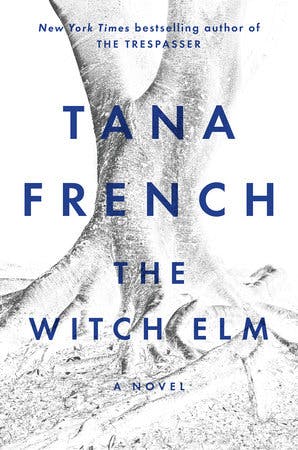
In 1943, four boys were poaching in the woods in Hagley, in the English county of Worcestershire. They climbed a wych elm and found a skull inside it. Authorities later found a whole skeleton, along with a wedding ring and a piece of taffeta inside the corpse’s mouth. Some graffiti appeared the next year on a Birmingham monument, reading, “Who Put Bella Down the Wych Elm - Hagley Wood.” The murder has never been solved, and the charismatic graffiti has inspired conspiracy theories ranging from witchcraft to spycraft, as discussed in a 2016 BBC Radio 4 investigation.
This incident is the inspiration for The Witch Elm, the new novel by Tana French, who is American but has lived for decades in Ireland. Her six previous novels, like In The Woods (2007) and Broken Harbor (2012), focused on ordinary Dubliners and the gruesome crimes that lead them to the attention of the fictional Dublin Murder Squad. The new book is a standalone work that, in a departure for French, uses a creepy historical exemplar to conduct a very modern investigation into the social politics of memory.
Our protagonist is Toby, a handsome guy in his late twenties, who has always been popular, had things easy. “Why didn’t you just file an actual complaint?” he asks his cousin Susanna, who has just told him about a bad experience she had with a doctor during her pregnancy. She responds with a hollow laugh: Toby doesn’t understand what it feels like when people don’t believe you.
But then Toby’s life is transformed. One night robbers break in to his home and beat Toby unconscious. He wakes in the hospital with a skull fracture and a traumatic brain injury. Deeply disturbed by the attack, Toby can’t bear to be touched, or go back to work. Things get worse: He finds out that his uncle Hugo is suffering from a brain tumor that will shortly kill him. Unable to sustain his independent life, Toby moves in with the sweet, bumbling Hugo and begins to assist him with his work as a genealogist.
As he adjusts to his new status as a disabled dependent, he is confronted by an old crime. While Susanna’s kids are out playing in Hugo’s garden they stumble on a human skull, hidden for who knows how long inside the hollow of an elm tree. Detectives show up. Whose skull is it? Why is it in the tree? Who has had access to the garden, and why can’t Toby remember what he needs to remember? He and his cousins used to have parties in the garden in their teenage years, but the details—which could be clues—are maddeningly fuzzy in his memory.
In a 2016 New Yorker piece about French, Laura Miller explained the connection between crime stories and the communities they’re set in: “All crime novels are social novels. They can’t help it; without a society to define, condemn, and punish it, crime itself wouldn’t exist.” In the case of The Witch Elm, French offers an analysis of how privilege (and the lack of it) defines a person’s experience of life.
As Toby tries to unravel the story of the skull, his memories of the past come into conflict with those of other people, including Susanna and his other cousin Leon. Though they went to school together, it turns out that the basic facts of their identities—that Toby is a man; that Susanna is a woman; that Leon is gay—have led the three cousins to have completely different recollections of their lives. Leon and Susanna have much more in common, both having felt marginalized as teenagers. Where does this leave Toby?
Always a white man who moved easily through the world, he feels belittled and emasculated by the robbery-attack, and condescended to by his doctors. Newly possessed of disability, though he can’t quite acknowledge it, Toby’s place in the food chain of social privilege has been radically reconfigured. He’s infuriated by the detectives who won’t tell him everything they know. He doesn’t trust Susanna or Leon; doesn’t know who to trust. He has a great girlfriend named Melissa, but she’s so angelic that there seems something suspicious about her.
French’s accomplishment is in turning the classic mystery novel ingredients—contradictory accounts, unreliable memory, dark family secrets—into a narrative about politics. We are aware that the main character can be somewhat entitled, but also that he is suffering from a brain injury. French invites the reader to make assumptions about his competency, to treat him as an unreliable narrator, because of his condition.
So, French’s readers are drawn into a complex tangle of ethics in which they are forced to question a disabled person’s perspective as a direct result of his disability. In The Witch Elm, we must reckon with two sets of ethics: The systemic discrimination that has given Toby a different life experience than Leon and Susanna, and also the game of revelation played out between author and reader.
The reader surveys the wreckage of French’s creation with a special insight that is most reminiscent of the detectives and the doctors of The Witch Elm—the people who unwittingly conspire to make Toby feel like a nothing, a nobody. Knowledge is a form of power, the novel implicitly argues. If it is dealt out unevenly in a society, then deep cracks are forged. On a metanarrative level, The Witch Elm is a profound reconsideration of power dynamics between the privileged and the less so, drawing the reader into an uneasy alliance with the former. It’s also a thrilling, absorbing mystery, sprinkled liberally with red herrings and culminating in a profoundly satisfying, if totally unforeseeable, ending. Tana French is at the cutting edge of crime fiction, and The Witch Elm pushes its boundaries further.
